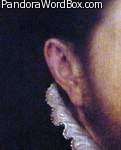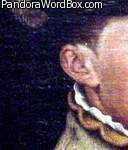Our websites offer information mostly for educational purposes with no intent to alter health care protocols nor to serve as a sole source of medical information.
Always seek the advice of your local health care provider.
|
×  Get the Point! PAIN – WOMAN – UKRAINE – PUTIN MOTHER – SISTER – SPOUSE – MOTHER RUSSIAN WAR – HOLOCAUST – GENOCIDE |
EARS in ART
Auricular Morphology Gallery (Adult Males)
(Part A)
The shape or morphology of the ear and nose reflect the growth to confluence of several cartilaginous starting primordial points or "anlage". This complex process is reflected in the considerable variability of nose - ear shapes which help as recognize each other. The personal "peculiarities" are least prominent among newborns and infants and are most prominent among mature persons. In fact naso-auricular structures enlarge with aging and more so among males. Note that during pre-puberty boys and girls have similar nose - ears. Another point of clinical relevance is that ears like fingerprints are useful to assess symmetry. Still another point is that ears and fingerprints are fairly unique thus are useful to establish identity. Dactyloscopy is the forensic reliance on fingerprint patterns for legal purposes.
Distinct ears of three prominent men. All three auricles are elongated, the outer rim (helix) is folded which is the norm among humans. "Monkeys" or mythic "Satyrs" have "unfolded" ears, meaning lack a helix. In front of the helix is the anti-helix which is most prominent in the central depiction. At the bottom of the auricle is the " ear lobule", most prominent and detached in the left depiction and is virtually absent in the right auricle. The opening of the ear canal is not visible but in front of its position, is the tragus prominence clearly depicted by the central image. A clinician would examine the left auricles of these individuals in search for signs of asymmetry. Furthermore, the individual on the right suffers from a "gene" disorder that disrupts the growth of the jaw. Prenatal development of the auricle and mandible are closely correlated. This individual's ear is "mal-rotated", implying that its longitudinal axis is closer to the horizontal than usual. During prenatal development, the auricular longitudinal axis is nearly horizontal. With growth of the jaw and face, the auricle "ascends" and the longitudinal axis approaches a vertical orientation. The auricle on the left appears "low set" and "malrotated". (regarding the terms helix, tragus, etc. and auricular clinical sigs, please explore further Pandora's Word Box and Clinical Eye Openers by clinking on the above box and icons)
Unusual ears are frequent as illustrated by the Roman emperor represented by two different sculptors as having "prominent" or "cup" ears. Often, "cup ears" result for a deficient development of the anti-helix. (for clinical examples please visit "Clinical Eye Openers" by clinking the icon above)
Finally, I like to stress that the above images illustrate the immense contributions by fine artists whose "eyes" demonstrably detected "signs" and led them to depict "signals" of the "individuality" of every "individual". Such capacity should be matched by clinicians but it is not. The main fountain of medical progress is to detect "distinct" signs as signals of a clinical disorder - blind clinicians hardly can do so but can be trained as well and as much as the artists who created a plethora of images. In Pandora's Word Box we honor artists who to this day stimulate our curiosity and inspire the need to understand distinctions of what is "normal" (mostly a statistical artifact), "individual" (variations), or "ab-normal" (pathologic).
W. Wertelecki, M.D.
20131121 20180630 ww












